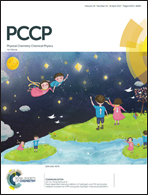Adsorption of small inorganic molecules on a defective MoS2 monolayer†
Abstract
We present a theoretical study of molecular adsorption on defects on a MoS2 monolayer. Based on Density Functional Theory, our calculations confirm that small inorganic molecules, such as CO2, CO, H2O, NO, NO2, H2 and N2, remain bonded to the pristine monolayer through weak van der Waals interactions, suggesting that the molecules may easily diffuse over the clean monolayer. On the other hand, the introduction of defects can lead to three different situations, depending on the defect and the molecule considered: physisorption, chemical (strong) bonding to the metallic defects, namely the Mo substitutional atoms on the S vacancies, and dissociation, that can take place spontaneously at 0 K in some specific cases or by the effect of thermal agitation in molecules such as CO2 or NO2 on the S vacancy. Our energetic and electronic analyses provide an explanation to such bonding possibilities, showing that in the low interacting situations, the molecules tend to adopt a planar configuration parallel to the monolayer, while a molecular rotation is favored in order to facilitate the bond formation on the reactive sites. Finally, the ab initio based Scanning Tunneling Microscopy (STM) simulations show the fingerprint of each molecule adsorbed on the most reactive site. This work opens the way to the possibility of tuning the catalytic properties of MoS2 by controlling the creation of specific defects in the MoS2 monolayer.



 Please wait while we load your content...
Please wait while we load your content...